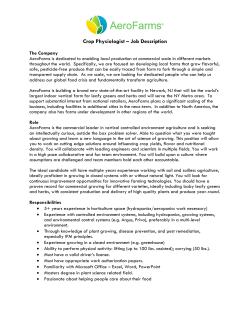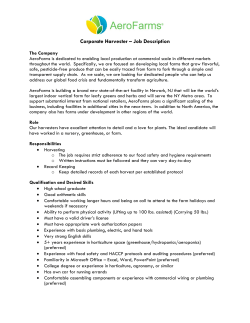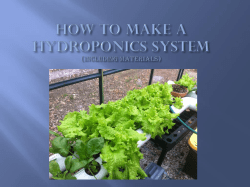
288-294 - International Journal of Agriculture and Crop Sciences
International Journal of Agriculture and Crop Sciences. Available online at www.ijagcs.com IJACS/2015/8-3/288-294 ISSN 2227-670X ©2015 IJACS Journal Quantitative And Qualitative Indices Of Peppermint Essential Oil In Water Stream, Classical Hydroponics And Soil Conditions G.S. Davtyan Institute of Hydroponics Problems, NAS RA Yerevan 0082, Noragyugh 108 Corresponding author email: m.daryadar@ymail.com ABSTRACT: For the first time we have carried out comparative investigations of the three varieties of the newest water-stream hydroponics (cylindrical, gully and continuous) in experimental modules with classical hydroponics and soil culture for revealing essential oil quantitative and qualitative peculiarities in planting material of valuable plant peppermint (Mentha piperita L.) belonging to the Lamiaceae family.In all the tested variants of peppermint planting material, essential oil synthesis was more intensive during the 3rd cut. Besides, cylindrical and classical hydroponics systems provided maximum output (1.6-2.6 times) of essential oil during the vegetation.We can see from the studies of essential oil qualitative indices that high content of Menthol (71-73%) was observed in cylindrical, classical and soil culture conditions. While gully and continuous variants provided a high content of Isomentone (11-15%). In cylindrical hydroponics maximum content of Menthol was observed in September (71%) and minimum content in August (40%). At the same time it turned out that biosynthesis of D-Limonene, Mentofuran and Piperidone was more intensive in August. Key words: water-stream hydroponics, peppermint, essential oil, menthol, productivity. INTRODUCTION Hydroponics is a phytotechnology of soilless cultivation of plants which is carried out in controlled culture conditions, in an artificial media but does not oppose to customary methods of intensive agriculture; it is a new, additional field of efficient use of human labor (Davtyan, 1969). Plant soilless production with classical hydroponics method is quite beneficial (Mairapetyan, 1989; Hovakimyan, 1975). However, building such hydroponicums with reinforced concrete beds requires great preliminary investments; therefore development of new and cheap hydroponics systems is one of the most important problems of economical productivity increase of soilless culture and its wide distribution. With that aim, development of new hydroponics systems is of great importance in the Institute of Hydroponics Problems (IHP) NAS, RA. The most promising among them is the water-stream hydroponics system developed in the result of 20-year investigations, with use of polymer film (Mairapetyan, 2007; Mairapetyan et al., 2009). The system has four varieties: continuous, cylindrical, gully and perennial (Mairapetyan et al., 2006, 2007, a, b, c). In spite of some differences, however, the main advantages are maintained: sharp decrease of expenditures for building a hydroponicum (5-6 times); providing an optimal air-water-heat-nutrient regime; significant savings on electricity, water and nutrient solutions, considerable increase of plant yield from nutrient unit surface and finally exclusion of environment pollution with use of a closed ecological system. In this regard we have carried out comparative investigations of the three varieties of the newest waterstream hydroponics (cylindrical, gully and continuous) in experimental modules with classical hydroponics and soil culture for revealing essential oil quantitative and qualitative peculiarities in planting material of valuable plant peppermint (Mentha piperita L.) belonging to the Lamiaceae family and studying its productivity. MATERIAL AND METHOD The studies have been carried out in the Ararat Valley conditions, which has dry continental climate, great fluctuations of temperature and humidity. Peppermint saplings obtained with hydroponics method (or in soilless Intl J Agri Crop Sci. Vol., 8 (0), 0000, 2015 culture) have been used during the investigations as planting material. In water-stream hydroponics the saplings 2 2 were planted in cylindrical, gully, continuous system with 8m nutrition surface and in 5m surface semi-productive 2 beds (8plants on 1m ) of hydroponics experimental station (HES). In all hydroponics systems 3-15mm diameter particles of volcanic slag were used as a substrate. The plants were nourished with G.S. Davtyan’s nutrient solution (Davtyan 1980), first with 0.5 concentration and one month later during all vegetation period 0.75n. In water-stream hydroponics depending on weather conditions the nutrient solution was pushed irretrievably in the form of jet to the root-bearing stratum of the plant 6-20 times, with 10-15second duration. The dosage of the nutrient solution supplied once was 20-30ml in spring and 30-50ml in summer and autumn. In classical hydroponics (CH) the plants were nourished 1-2 times in spring and autumn and 2-3 times in summer. In soil culture the accepted agricultural rules were observed (soil loosening, weed removal, regular watering: 3-4 times a day, fertilization). The harvest was done in three periods: 1st cut - July, 2nd cut- August and 0 3rd cut September. The raw medicinal material was dried in ventilated rooms, in 20-30 С conditions. The content of essential oil in dry raw medicinal material was determined according to State Pharmacopeia SPh XI (State Pharmacopeia USSR. 1990) and the qualitative analysis of the essential oil was carried out with EM 640S model modern gas-chromate-mass-spectrometer (GCH-MS) of Bruker Daltonik company, with “HP-5MS” method. Component identity of essential oil was determined both according to NIST-MS computer library data and with the help of comparative samples. The replication of the experiments was 4-8 fold. The results were submitted to mathematical working out (Dospechov 1985). RESULTS AND DISCUSSION Growth peculiarities of the investigated plant and its productivity indices in conditions of different hydroponics systems and in soil culture vary significantly which is the result of a number of factors providing growth, development and productivity of plants in soilless culture. So, the planting material of peppermint obtained with use of different hydroponics methods, except continuous, exceeds the soil culture with dry weight 1.5-2.7 times (table 1, fig. 1). At the same time it turned out that cylindrical hydroponics system is superior compared to other variants and it provided 1.8-2.2 times dry weight increase of peppermint raw medicinal material. According to the obtained data regardless of cultivation conditions over 37-47% of the total yield was provided during the 3rd cut. Figure 1. Peppermint in the water-stream hydroponics system conditions Intl J Agri Crop Sci. Vol., 8 (0), 0000, 2015 Table 1.Peppermint yield according to cuts in different hydroponics systems and soil culture conditions Variant Dry weight of raw medicinal material, g/plant total I cut 155.1 45.7 83.7 25.6 69.7 13.1 149 53.1 57 16.8 15.3 Cylindrical Gully Continuous CH Soil (control) LED05 II cut 43.9 24.7 23.7 40.7 14.7 III cut 65.5 33.4 32.9 55.1 25.5 According to the presented data (table 2, 3) in all the tested variants of the raw medicinal material of peppermint, the essential oil synthesis was the most intensive during the 3rd cut. It should be noted that among the tested systems due to high productivity of peppermint cylindrical and classical hydroponics systems provided maximum output (1.6-2.6 times) of essential oil per plant during vegetation. The raw medicinal material of the obtained peppermint mostly meets the requirements of USSR SPh XI (State Pharmacopeia USSR. 1990). Table 2.The content of essential oil in peppermint according to cuts, % essential oil I cut II cut III cut Cylindrical 4.02 3.55 4.38 Gully 3.95 3.84 4.68 Continuous 3.68 3.68 4.42 CH 3.88 3.46 4.06 Soil (control) 3.51 4.33 4.43 Table 3. Phamachemical indices of peppermint* Essential oils (according to SPh XI not less than 1%) Variant Cylindrical Gully Continuous CH Soil (control) % 3.98 4.16 3.93 3.8 4.09 output g/plant 6.15 3.48 2.74 5.66 2.33 Humidity (according to Sph XI not more than 14%) % 9.7 10.0 9.7 9.3 10.6 Total ash (according to Sph XI not more than 14%) % 12.8 13.2 13.7 14.2 14.8 Insoluble ash in 10% HCl (according to Sph XI not more than 6%) % 1.1 1.3 1.2 1.1 2.5 *average of 3 cuts is presented In essential oil plants the essential oil undergoes not only quantitative but also qualitative changes during growth and development (Mairapetyan, 1989, Manukyan, 2001). According to literature data the chemical composition of peppermint essential oil is quite complex. It contains over 30 terpene elements (Physico-chemical peppermint oil, 2010). The main compounds which determine the quality of essential oil are Menthol and Menthone with Isomentone. The essential oil obtained from the leaves and inflorescences due to high content of menthol is widely used for treating cardiovascular, respiratory, kidney diseases, migraine as well as other diseases and the leaves are used in case of gastrointestinal diseases as a calming, anti-inflammatory, blood pressure lowering remedy. It is also used in production of perfumes, soaps, sweets (Mairapetyan et al., 2006; Lebeda et al., 2006; Biological peculiarities, 2010; Buchbauer, 2010). The results of the experiments carried out for the first time by us in water stream and classical hydroponics and in soil culture conditions have shown (table 4, fig. 2) that the qualitative indices of essential oil in the tested variants vary considerably. Overall, high content of Menthol (71-73%) was observed in cylindrical and classical hydroponics, as well as in soil culture conditions. In case of the mentioned variants the content of Menthol increases on average 1.1-1.4 times compared to continuous and gully hydroponics. However, gully and continuous hydroponics had a high content of Isomentone (11-15%). 1It is known that the essential oil has a certain chemical compound in each part of the vegetation period (Mairapetyan, 1980). So, the discussed issue is essential for determining the right optimal period of harvest which will give an opportunity to have a higher content of essential oil from a certain valuable component if the harvest is carried out in the appropriate period. 1 Among the tested variants cylindrical hydroponics system provides maximum output of peppermint planting material and secondary origin important element – essential oil. Intl J Agri Crop Sci. Vol., 8 (0), 0000, 2015 In the result of the carried out studies (table 5, fig. 3) it turned out that in cylindrical hydroponics system maximum amount of Menthol was observed in September (71.4%) and minimum amount in August (40.0%). General qualitative and quantitative comparison of maximum (1st and 3rd cuts) and minimum (2nd cut) content of peppermint essential oil in conditions of cylindrical hydroponics is very interesting. In fact, in the mentioned period the decrease of the essential oil (4.4-3.6%) was followed by decrease of main compounds of essential oil such as Menthol (71.4-40.0%), Isomentone (12.0-6.4%) Mint-furanone (8.1-3.0) and increase of D-Limonene (0.7-3.3%), Mentofuran (0.6-13.3%), piperidone (1.1-1.4%). Qualitative studies of essential oil have shown that as a rule in the second cut /August/ of vegetation biosynthesis of D-Limonene, Mentofuran and Piperidone were more intensive. However, in case of Pulegone, in September: at the end of vegetation there was considerable decrease of its content 15-16 times (32.1- 2.06%). We can also see from the table analysis that parallel to decrease of Menthol content, Pulegone increase was observed. Cylindrical Gully classical hydroponics Continuous Soil Figure 2. Processing of peppermint essential oil grown in different conditions of GC-MS (the numbers in fig. 2 are the same as the ones in table 4) Intl J Agri Crop Sci. Vol., 8 (0), 0000, 2015 Table 4.Peppermint essential oil chemical characteristics of water stream and classic hydroponics, as well as soil culture conditions 1 2 3 4 5 6 7 8 9 10 11 12 D-Limonene Isomentone Mentofuran Menthol Cuminal Valeric acid Pulegone Piperidone Menthyl acetate Mint furanone Caryophyllene Carboxylic acide Cylindrical time F 10.27 93.2 13.13 97.7 13.34 95.6 13.58 986 14.47 86.8 ----14.96 95.8 15.28 97.6 16.02 99.5 17.18 85.0 ----20.95 76.8 Gully % 0.86 7.30 2.50 71.43 1.08 --2.06 1.15 3.32 8.05 --2.24 time 10.59 13.68 13.90 14.29 15.10 15.41 15.64 15.97 16.74 21.04 19.47 20.96 F 96.7 97.7 99.1 97.9 86.5 96.1 96.0 68.6 99.4 98.5 983 78.4 % 3.10 11.2 8.22 65.6 0.50 0.19 1.88 1.16 4.43 2.74 0.38 0.60 Continuous time 10.72 13.74 13.95 14.23 15.15 15.46 15.68 16.00 16.76 21.06 19.82 22.07 F 93.2 98.2 98.2 86.9 85.8 95.8 96.6 98..2 99.4 98.7 96.3 79.3 % 0.32 14.77 0.16 50.92 0.19 0.23 6.71 0.93 1.45 17.07 0.20 7.00 CH Time 10.27 13.43 13.39 8.56 14.35 14.88 15.07 15.40 16.18 17.40 18.80 21.38 F 97.5 96.7 91.9 98.5 86.2 96.1 95.8 95.0 99.0 86.7 98.5 78.9 % 2.17 9.21 11.80 72.16 0.06 0.45 2.59 3.82 20.54 10.04 1.33 3.50 Soil time 10.21 13.09 13.30 13.58 14.43 16.64 14.93 15.24 15.98 17.14 18.50 20.86 F 95.9 97.9 97.9 97.9 85.9 96.9 93.2 97.8 99.5 81.3 95.3 78.9 % 1.74 6.76 7.15 73.36 0.51 0.24 0.62 1.04 5.55 2.14 0.20 0.57 * An overview of the most numerous and highly probable identity (F) of the components. Table 5. Peppermint essential oil qualitative composition in cylindrical hydroponics system Variant 1 2 3 4 5 6 7 8 9 10 11 12 D-Limonene Isomentone Mentofuran Menthol Cuminal Valeric acid Pulegone Piperidone Menthyl acetate Mint furanone Caryophyllene Carboxylic acide 1-cut Registration time, minutes 10.19 13.09 13.28 13.57 14.42 14.77 14.96 15.23 15.97 19.94 18.50 20.91 F% 96.8 99.1 92.6 97.7 93.7 96.0 97.6 98.3 99.1 86.3 98.6 76.9 Content % 0.70 12.02 0.55 54.61 0.33 0.22 32.08 1.09 0.57 3.8 0.30 1.74 2-cut Registration time, minutes 10.26 13.42 13.37 13.72 14.47 14.86 15.07 15.30 16.02 19.99 18.54 20.94 F% 97.4 95.9 98.7 83.1 87.2 96.4 97.6 98.6 99.6 98.2 98.1 77.3 Content % 3.34 6.42 13.26 40.03 0.52 0.47 29.0 1.43 0.88 2.98 0.76 0.93 3-cut Registration time, minutes 10.27 13.13 13.34 13.58 14.47 --14.96 15.28 16.02 17.18 --20.95 F % 93.2 97.7 9.56 98.6 86.8 --95.8 97.6 99.5 85.0 --76.8 Content % 0.86 7.30 2.50 71.43 1.08 --2.06 1.15 3.32 8.05 --2.24 Intl J Agri Crop Sci. Vol., 8 (3), 288-294, 2015 rd rd 1 cut 2 cut rd 3 cut Figure. 3. GC-MS of peppermint essential oil in cylindrical hydroponics system according to cuts (the numbers in fig. 3 are the same as the ones in table 5) CONCLUSION The planting material of peppermint obtained with the application of different hydroponics methods, except continuous, exceeds the soil culture with dry weight 1.5-2.7 times. At the same time, cylindrical hydroponics system is superior to gully and continuous systems, which have provided dry weight increase of peppermint raw medicinal material 1.8-2.2 times. Essential oil biosynthesis was more intensive during the 3rd cut. Besides that, cylindrical and classical hydroponics systems provided maximum output (1.6-2.6 times) of essential oil during vegetation. High content of Menthol (71-73%) in the essential oil was observed in cylindrical, classical and soil culture conditions. However, gully and continuous variants had a hight content of Isomentone (11-15%). In cylindrical hydroponics maximum content of Menthol was observed in September (71%) and minimum content in August (40%). Moreover, parallel to the reduction of menthol content increase of Pulegone was observed. At the same time, it turned out that the biosynthesis of D-Limonene, Mentofuran and Piperidone was more intensive in August. 293 Intl J Agri Crop Sci. Vol., 8 (3), 288-294, 2015 REFERENCES Buchbauer G.2010. Handbook Of Essentioal Oils Science, Technology, And Applications. P.994. Davtyan GS. 1969. Hydroponics As A Production Achievement Of Agrochemical Science. Xviii Scientific Reading, Dedicated To The Memory Of Academician D.N. Pryanishnikov. Ed. As Arm. Ssr, , P. 85. Davtyan GS, Mairapetyan SKh.1976. “Soilless Cultivation Of Rose Geranium՛՛, Armenian Ssr Na Publishing, Yerevan, , P. 88-95: Davtyan GS.1980. Hydroponics. Reference Book On Chemicalization Of Agriculture. M. Kolos: P.382-385. Dospechov BA.1985. Field Experiment Method Moscow, Russia: 223-228. Hovakimyan AB. 1975. Economical Efficiency And National Economic Significance Of Hydroponics. Yerevan, , P.117. http://www.floraprice.ru/articles/apteka/podarok-skazachnoj-nimfy.html Lebeda AF, Jurenko NI, Isaykina AP, Sobko BG. 2006. Medicinal Plants: The Fullest Encyclopedia. M.: Ast-Press Book: 79-80,. Mairapetyan SKh. 2007. Nas Ra Institute Of Hydroponics Problems In 60 Years//Nas Ra Ihp Communications, , N31, P. 3-16: Mairapetyan SKh, Daryadar MKh, Alexanyan JS, Tadevosyan AH, Tovmasyan AH, Stepanyan BT, Galstyan HM. 2013. Comparative Description Of Productivity And Content Of Biologically Active Substances Of Some Essential Oil-Bearing Plants In Conditions Of New Water Stream Hydroponics.Biological Journal Of Armenia, 3 (65), 80-84,. Mairapetyan S.Kh. 1989. “The Culture Of Essential Oil Plants In Open-Air Hydroponic Conditions”. Yerevan: Publisher Ah Arm Ssr: 313. Mairapetyan SKh, Tadevosyan AH, Hovsepyan AH, Mairapetyan KhS.2006. “Method Of Soilless Cultivation Of Plants And Their Implementation System”, Invention Patent Of Ra, No1849 A2. Mairapetyan SKh, Tadevosyan AH, Hovsepyan AH, Mairapetyan KhS. 2007 a. “Method Of Soilless Cultivation Of Planted Crops And Their Implementation System”, Invention Patent Of Ra, No1946 A2. Mairapetyan SKh, Tadevosyan AH, Hovsepyan AH, Mairapetyan KhS.2007b. “Method Of Soilless Cultivation Of Sowed Herbs And Their Implementation System”, Invention Patent Of Ra, No1988 A2 Mairapetyan SKh, Tadevosyan AH, Hovsepyan AH, Mairapetyan KhS. 2007c. “Method Of Soilless Cultivation Of Herbs And Their Implementation System”, Invention Patent Of Ra, No1989 A2. Mairapetyan SKh, Tadevosyan AH, Hovsepyan AH, Mairapetyan KhS. 2009. “New System Of Soilless Production Of Plants-Water Stream Hydroponics”.Communications, Ihp Nas Ra,Yerevan, No (32): 13-23. Manukyan AE. 2001.Biotechnology development of Greater Celandine (Chelidonium majus L.) and Catnip Peppermint (Nepeta cataria L. f.citriodora) . (2001) in open-air hydroponic conditions. Summery, Abovyan-, p. 3-31. Peppermint (Mentha Piperita L.), Biological peculiarities, cultivation, use in medicine, cosmetics and cooking. 2010 Perejogina V. 2010 Http://Www.Floraprice.Ru/Articles/Apteka/Podarok-Skazachnoj-Nimfy.Html Physico-Chemical Indices of Peppermint Oil Of Different Origin. 2010. Http://Www.Vesex.Ru/Pdf/Mentha.Pdf. State Pharmacopeia USSR. 190 Xi, Edition 2. M.: Medicine 294
© Copyright 2025









